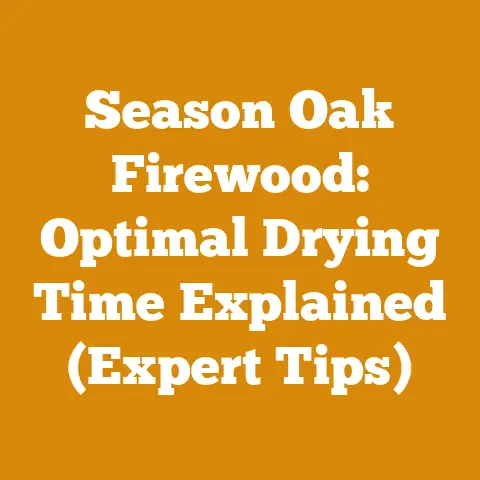7 Pin Trailer Light Tester Box (5 Pro Tips for Wood Hauling)
Alright, folks, let’s talk trailer lights!
Ever felt like you’re conducting a symphony of blinks and flashes with your trailer lights, but nobody knows the score?
I’ve been there.
Picture this: It’s late, you’re hauling a load of freshly split oak, and suddenly your tail lights decide to have a rave.
Not ideal.
That’s where the 7-Pin Trailer Light Tester Box comes in, and I’m here to give you the lowdown with 5 pro tips for wood hauling.
Understanding the 7-Pin Trailer Light Tester Box
Before diving into the tips, let’s get clear on what this little gadget is all about.
The 7-pin trailer light tester box is designed to quickly diagnose electrical issues with your trailer lights.
Instead of guessing which wire is causing the problem, it allows you to test each circuit individually.
This is a game-changer, especially when you’re dealing with the vibrations, moisture, and general wear-and-tear that come with hauling heavy loads like firewood.
What a 7-Pin Tester Does
The tester typically has a series of LED lights that correspond to each pin in the 7-pin connector.
When you plug the tester into your trailer’s connector, each light should illuminate when the corresponding function (left turn, right turn, brake lights, etc.) is activated in your tow vehicle.
If a light doesn’t illuminate, you know there’s a problem with that specific circuit.
Why It’s Essential for Wood Hauling
Hauling wood is tough on your equipment.
The constant jostling can loosen connections, fray wires, and generally wreak havoc on your trailer’s electrical system.
Plus, wood is often hauled in less-than-ideal conditions – think muddy logging roads and wet weather.
A 7-pin tester allows you to quickly identify and fix problems before they lead to bigger issues, like a ticket or, worse, an accident.
Pro Tip 1: Pre-Haul Light Check – Your First Line of Defense
I always say, an ounce of prevention is worth a pound of cure.
This is especially true when hauling wood.
Before you even think about loading up your trailer, do a complete light check using your 7-pin tester.
The Process
- Connect the Tester: Plug the tester into your trailer’s 7-pin connector.
- Engage Tow Vehicle: Turn on your tow vehicle and have someone activate each light function (left turn, right turn, brake lights, running lights, reverse lights, and auxiliary power if applicable).
- Observe: Watch the LED lights on the tester.
Each light should illuminate when the corresponding function is activated. - Record Findings: Make a note of any lights that don’t illuminate.
This is where you’ll need to focus your troubleshooting efforts.
Why This Matters
This simple check can save you a lot of headaches down the road.
By identifying issues before you leave, you can address them in your driveway, where you have access to tools and parts, rather than on the side of a busy road.
Real-World Example
I remember one time, I skipped this check and ended up with a brake light failure halfway to my wood lot.
I had to pull over, rummage through my toolbox, and spend an hour tracing wires in the dark.
Now, it’s the first thing I do before every haul.
Pro Tip 2: Inspect Your Wiring and Connections Regularly
The 7-pin tester is great for diagnosing problems, but it’s even better if you can prevent them in the first place.
Regular inspection of your trailer’s wiring and connections is crucial.
What to Look For
- Corrosion: Check for corrosion on the connector pins and wiring terminals.
Corrosion is a common culprit for light failures, especially in wet environments. - Loose Connections: Make sure all connections are tight and secure.
Vibration can loosen connections over time. - Frayed Wires: Inspect the wiring for any signs of fraying or damage.
Replace any damaged wires immediately. - Grounding Issues: Ensure the trailer is properly grounded.
A poor ground can cause all sorts of electrical problems.
How to Prevent Issues
- Use Dielectric Grease: Apply dielectric grease to the connector pins to prevent corrosion.
- Secure Wiring: Use zip ties or electrical tape to secure the wiring and prevent it from rubbing against the trailer frame.
- Regular Cleaning: Clean the connector and wiring terminals regularly to remove dirt and debris.
My Personal Experience
I once had a recurring issue with my trailer lights cutting out intermittently.
After several frustrating troubleshooting sessions, I discovered that the ground wire was loose and corroded.
A quick cleaning and tightening of the connection solved the problem.
Now, I make it a point to inspect and clean all connections at least twice a year.
Pro Tip 3: Carry Essential Tools and Spare Parts
Even with the best preventative maintenance, things can still go wrong.
That’s why it’s essential to carry a basic toolkit and spare parts with you when hauling wood.
Essential Tools
- Multimeter: A multimeter is invaluable for diagnosing electrical problems.
It allows you to measure voltage, current, and resistance. - Wire Strippers/Crimpers: These are essential for repairing or replacing wiring.
- Screwdrivers: A set of screwdrivers will come in handy for tightening connections and removing screws.
- Pliers: Pliers are useful for gripping and manipulating wires.
- Electrical Tape: Electrical tape is essential for insulating and protecting wiring.
Spare Parts
- Spare Bulbs: Carry spare bulbs for all of your trailer lights.
- Spare Fuses: Keep a selection of spare fuses on hand.
- Wire Connectors: Have a variety of wire connectors available for making repairs.
- Extra Wire: Carry a roll of extra wire in case you need to replace a section of damaged wiring.
Why This Matters
Having these tools and parts on hand can allow you to make quick repairs on the spot, rather than being stranded on the side of the road.
Story Time
I was once hauling a load of firewood late at night when one of my tail lights went out.
Luckily, I had a spare bulb and a screwdriver in my toolkit.
I was able to replace the bulb in a few minutes and get back on the road without any further delay.
Pro Tip 4: Understand Common Trailer Light Problems
Knowing the common issues with trailer lights can help you diagnose problems more quickly and efficiently.
Common Problems
- Corrosion: As mentioned earlier, corrosion is a major cause of trailer light problems.
- Loose Connections: Vibration can loosen connections over time, causing lights to fail.
- Grounding Issues: A poor ground can cause a variety of electrical problems.
- Blown Fuses: Overloading the circuit can cause fuses to blow.
- Short Circuits: Damaged wiring can cause short circuits, which can blow fuses or damage your trailer’s electrical system.
- Bulb Failure: Bulbs can burn out over time, especially incandescent bulbs.
Troubleshooting Tips
- Start with the Basics: Check the bulbs and fuses first.
These are the easiest things to replace. - Check the Ground: Make sure the trailer is properly grounded.
- Trace the Wiring: Use a multimeter to trace the wiring and identify any breaks or shorts.
- Test the Connector: Use the 7-pin tester to isolate the problem to a specific circuit.
Insights from the Field
I’ve found that a lot of trailer light problems are caused by simple things like corroded connections or loose wires.
Taking the time to inspect and clean your wiring regularly can go a long way towards preventing these issues.
Pro Tip 5: Upgrade to LED Lights for Durability and Reliability
If you’re tired of constantly replacing bulbs and dealing with trailer light problems, consider upgrading to LED lights.
Benefits of LED Lights
- Longer Lifespan: LED lights last much longer than incandescent bulbs.
- Increased Brightness: LED lights are brighter and more visible, especially in daylight.
- Lower Power Consumption: LED lights use less power, which can reduce the load on your tow vehicle’s electrical system.
- Greater Durability: LED lights are more resistant to vibration and impact.
- Water Resistance: Many LED lights are sealed and waterproof, making them ideal for use in wet conditions.
The Investment
While LED lights are more expensive upfront, they can save you money in the long run by reducing the need for replacements and repairs.
My LED Conversion
I switched to LED trailer lights a few years ago, and I haven’t had a single light failure since.
The increased brightness and durability are well worth the investment.
Plus, I don’t have to worry about carrying spare bulbs anymore.
It’s one of the best upgrades I’ve made to my wood-hauling setup.
Bonus Tips for Safe Wood Hauling
Beyond the 7-pin tester and trailer lights, here are a few extra tips to keep you safe while hauling wood:
Load Securely
- Distribute Weight Evenly: Distribute the weight of your load evenly over the trailer axles.
- Secure the Load: Use straps, chains, or ropes to secure the load and prevent it from shifting during transport.
- Check Load Height: Make sure the load doesn’t exceed the maximum height allowed in your area.
Drive Safely
- Reduce Speed: Reduce your speed when hauling a heavy load.
- Increase Following Distance: Increase your following distance to allow for longer braking times.
- Avoid Sudden Movements: Avoid sudden braking, accelerating, or turning.
- Check Tire Pressure: Check the tire pressure on both your tow vehicle and trailer before each trip.
- Take Breaks: Take frequent breaks to avoid fatigue.
Maintain Your Equipment
- Regular Inspections: Inspect your trailer and tow vehicle regularly for any signs of wear or damage.
- Brake Maintenance: Keep your brakes in good working order.
- Wheel Bearing Maintenance: Grease your wheel bearings regularly.
The Bottom Line on Safety
Safety should always be your top priority when hauling wood.
By following these tips, you can help ensure that you and your load arrive safely at your destination.
Deep Dive: Understanding Trailer Wiring Diagrams
Okay, let’s get a bit technical.
Understanding trailer wiring diagrams can seem daunting, but it’s a skill that will pay off big time when troubleshooting electrical issues.
The Standard 7-Pin Connector
The 7-pin connector follows a standard wiring configuration, which makes it easier to diagnose problems.
Here’s a breakdown of each pin:
- Pin 1 (Yellow): Left Turn/Stop Light
- Pin 2 (Blue): Electric Brakes
- Pin 3 (White): Ground
- Pin 4 (Green): Right Turn/Stop Light
- Pin 5 (Brown): Tail Lights/Running Lights
- Pin 6 (Red): Stop Light (Sometimes used for auxiliary power)
- Pin 7 (Black): 12V Power (Auxiliary Power)
Reading a Wiring Diagram
A trailer wiring diagram is a visual representation of the electrical circuits in your trailer.
It shows the location of each wire, connector, and component.
- Symbols: Familiarize yourself with the common symbols used in wiring diagrams, such as resistors, capacitors, diodes, and fuses.
- Color Coding: Pay attention to the color coding of the wires.
This can help you trace the wiring and identify the correct connections. - Circuit Tracing: Use the diagram to trace the flow of electricity through the circuit.
This can help you identify the source of a problem.
Example Scenario
Let’s say your left turn signal isn’t working.
Using the wiring diagram, you can trace the circuit from the tow vehicle’s connector to the left turn signal bulb on the trailer.
This will help you identify any breaks or shorts in the wiring.
Case Study: Troubleshooting a Complex Electrical Issue
I once helped a friend troubleshoot a complex electrical issue on his logging trailer.
His lights were flickering intermittently, and he couldn’t figure out what was causing the problem.
The Symptoms
- Flickering lights
- Intermittent brake light failure
- Occasional blown fuses
The Troubleshooting Process
- Initial Inspection: We started by inspecting the wiring and connections.
We found some corrosion on the connector pins, but nothing major. - 7-Pin Tester: We used the 7-pin tester to isolate the problem to a specific circuit.
- Multimeter Testing: We used a multimeter to test the voltage and continuity of the wiring.
We found a voltage drop in the ground wire. - Grounding Issues: We traced the ground wire and discovered that it was loose and corroded at the frame connection.
- The Solution: We cleaned and tightened the ground connection, and the problem was solved.
Lessons Learned
This case study highlights the importance of thorough troubleshooting and attention to detail.
Even seemingly minor issues, like a loose ground connection, can cause significant electrical problems.
Tool Spotlight: The Digital Multimeter
A digital multimeter (DMM) is an indispensable tool for anyone working with electrical systems.
It allows you to measure voltage, current, resistance, and continuity.
Key Features
- Voltage Measurement: Measures the electrical potential difference between two points.
- Current Measurement: Measures the flow of electrical charge.
- Resistance Measurement: Measures the opposition to the flow of electrical current.
- Continuity Testing: Checks for a complete electrical path between two points.
How to Use a Multimeter
- Select the Function: Turn the dial to the appropriate function (voltage, current, resistance, continuity).
- Connect the Leads: Connect the test leads to the appropriate terminals on the multimeter.
- Apply the Leads: Apply the test leads to the circuit or component you want to test.
- Read the Display: Read the measurement on the digital display.
Safety Precautions
- Never Measure Voltage on a Live Circuit: Always disconnect the power before measuring voltage.
- Use the Correct Range: Select the appropriate range for the measurement you’re taking.
- Avoid Short Circuits: Be careful not to create a short circuit when using the multimeter.
Advanced Techniques: Load Testing and Voltage Drop Analysis
For more advanced troubleshooting, you can use load testing and voltage drop analysis to identify subtle electrical problems.
Load Testing
Load testing involves applying a load to the circuit and measuring the voltage and current.
This can help you identify weak or overloaded circuits.
Voltage Drop Analysis
Voltage drop analysis involves measuring the voltage drop across a section of wiring.
A significant voltage drop can indicate a problem with the wiring, such as corrosion or a loose connection.
How to Perform Voltage Drop Analysis
- Apply a Load: Apply a load to the circuit.
- Measure Voltage: Measure the voltage at the beginning and end of the section of wiring you want to test.
- Calculate the Voltage Drop: Subtract the voltage at the end of the section from the voltage at the beginning.
- Interpret the Results: A voltage drop of more than 0.5 volts indicates a problem with the wiring.
Keeping Up with the Latest Technology
The world of trailer lighting is constantly evolving.
Here are some of the latest trends and technologies to be aware of:
Wireless Trailer Lights
Wireless trailer lights eliminate the need for a physical wiring connection between the tow vehicle and the trailer.
They use a wireless transmitter to send signals to the trailer lights.
Smart Trailer Lighting Systems
Smart trailer lighting systems offer advanced features such as automatic light dimming, turn signal synchronization, and brake light modulation.
Solar-Powered Trailer Lights
Solar-powered trailer lights use solar panels to charge a battery that powers the lights.
This can be a convenient option for trailers that are stored outdoors.
Conclusion: Light Up Your Wood Hauling Experience
So, there you have it!
The 7-Pin Trailer Light Tester Box is your trusty sidekick in the wood-hauling world.
By following these pro tips, you can keep your trailer lights working properly, stay safe on the road, and avoid those frustrating roadside repairs.
Remember, a little preventative maintenance and a good understanding of your trailer’s electrical system can go a long way.
Now get out there, haul that wood, and keep those lights shining bright!






